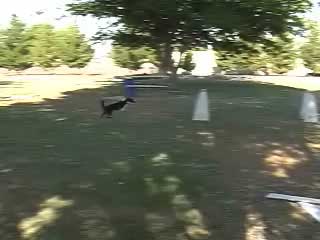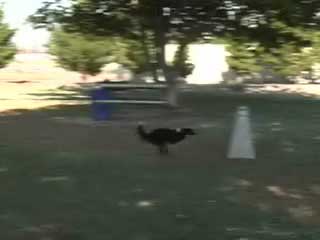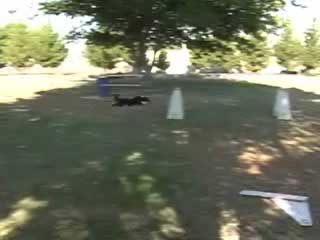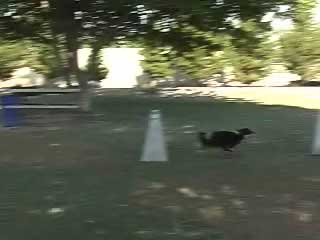
Changing a dog's release point may have a dramatic effect on the dog's entire run as shown by two of Brady's restraint recalls. On the first run, Brady was released at 45' from the start line. She was then moved forward 5' and released at 40' on her next run.
45' Release
40' Release
Note the effect on her take-off point. On the 45' release she started jumping far too soon, whereas on the 40' release her take-off point was 5' from the jump which produced a perfectly balanced jump.
 45' Release
45' Release
 40' Release
40' Release
Because of jumping too soon, Brady had to jump far higher in order to clear the hurdle, whereas when jumping from the correct point she was able to run much lower and faster. The top of Brady's arc is well before the jump in the first place, but directly over the jump in the second.
 45' Release
45' Release
 40' Release
40' Release
Instead of hopping through the jumps, she is now able to run through them.
There is a domino effect taking place. In the first case, Brady lands too close after the jump and all the way through continues hopping over each jump. On the second run she lands further from the jump and has a take-off point dead center to the jumps staying low and fast.
 45' Release
45' Release
 40' Release
40' Release
Finally, Brady lands only two feet out from the last jump with a 45' release, but five feet out from the last jump with a 40' release. This means she is three feet closer to the box at the same point in her run. This will affect her box turn just as dramatically. Even though she has an excellent box turn, if she lands too far from the box on her run down, she will not be able to get all four feet up on the box to do the turn she was trained for. This may result in the dog doing a two or three foot turn or having a very wide turn. The handler may mistakenly think the dog needs more training on the turn, when the dog's striding was actually the problem. In the second case, the dog will be close enough to the box to get all four feet up and do the turn she knows how to do. Of course this will then affect the run back as well. With a proper turn the dog gets further out when coming off the box, which sets the dog up for the proper striding over the jumps on the recall. An improper turn may result in the dog throwing in an extra stride, or hopping over the jumps on the way back, slowing it down appreciably.
Moving Brady's release point closer to the jump than 40' would then start causing similar striding problems also slowing her run down. The main thing to watch for is the effect changing the release point has on the dog's take-off point over the first jump. This point is optimally five feet from the jump all the way through, to produce the lowest, fastest run. I prefer to measure out my release point at every practice so the dog always knows what to expect and can run down at full speed without worrying about adjusting its stride. We have often seen dogs slowing down to make their stride adjustment when entering the jumps, which slows their entire run down.
Dog's will often adjust their striding to hit their own prefered take-off point. The most gifted jumpers and natural athletes may be affected very little by changing their release points. Quite often the dog chooses the incorrect point to jump from though. The two most common mistakes are jumping from the start line (a foot too soon), and jumping when passing the dog coming back. So changing a dog's release point is not a cure for bad striding, but may play an important role, and proper striding to produce a balanced jump and good turn will significantly lower a dog's time.